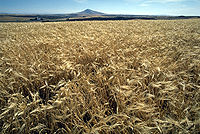- Cereal germ
-
The germ of a cereal is the reproductive part that germinates to grow into a plant;[1] it is the embryo[2] of the seed. Along with bran, germ is often a by-product of the milling[3] that produces refined grain products. Cereal grains and their components, such as wheat germ,[4] rice bran, and maize[5] may be used as a source from which vegetable oil is extracted, or used directly as a food ingredient. The germ is retained as an integral part of whole grain foods.[6]
Contents
Wheat germ
Wheat germ is a concentrated source of several essential nutrients including Vitamin E, folate (folic acid), phosphorus, thiamin, zinc and magnesium, as well as essential fatty acids and fatty alcohols.[7][8] It is a good source of fiber.[9] White bread is made using flour that has had the germ and bran removed.[10] Wheat germ can be added to protein shakes, casseroles, muffins, pancakes, cereals, yogurt, cookies, and other goods.[11] Wheat germ can become rancid if not properly stored in a refrigerator or freezer,[12] and away from sunlight.[13] Some manufacturers prevent rancidity by storing wheat germ in vacuum sealed glass containers.
Other uses
In molecular biology, wheat germ extract is used to carry out in vitro translation experiments, as the plant embryo contains all the macromolecular components necessary for translating mRNA into amino acids, but contains relatively low levels of its own mRNA.[14]
Wheat germ is also useful in biochemistry as it contains lectins which bind strongly to certain glycoproteins, hence it can be used to isolate such proteins.
See also
Notes
- ^ Black, Michael J.; J. Derek Bewley, Peter Hunter (2006). The Encyclopedia of Seeds - Science, Technology and Uses. CAB International. http://books.google.com/books?id=aE414KuXu4gC&pg=PA143&ei=qDFWSv7iO4bYlATN6filBw. Retrieved 09-July-2009. "The embryo is that part of the seed which germinates and grows into the vegatative plant. In cereal grains, embryos (germs)..."
- ^ Ellis, Carleton; Annie Louise Macleod (1922). Vital Factors of Foods - Vitamins and Nutrients. D. Van Nostrand Company. http://books.google.com/books?id=MDZKAAAAMAAJ&pg=PA78&ei=DjBWSuXeDIuolQTyu8GzBw. Retrieved 09-July-2009. "...the germ or embryo of the grain..."
- ^ Hui, Yiu H.; Ramesh C. Chandan, Stephanie Clark, Nanna Cross, Joannie C. Dobbs, William J. Hurst, Erika B. Smith, Leo M. Nollet, Eyal Shimoni, Nirmal Sinha (27-April-2007). Handbook of Food Products Manufacturing: Principles, Bakery, Beverages, Cereals, Cheese, Confectionary, Fats, Fruits, and Functional Foods. Wiley-Interscience. ISBN 0470125241. http://books.google.com/books?id=mnh6aoI8iF8C&pg=PA374&ei=cDpWSoCqHpLilASpgKmxBw. Retrieved 09-July-2009. "There are two methods that are used for the dry-milling process: milling without removal of the cereal germ, the oldest method, and milling with removal of the cereal germ, the method most used today to ensure a better preservation."
- ^ Keville, Kathi; Mindy Green (16-December-2008). Aromatherapy. The Crossing Press. ISBN 1580911897. http://books.google.com/books?id=G7wd8N_jNJcC&pg=PA46&ei=r0lWSrn1PJXkkQT7v4C3Bw. Retrieved 09-July-2009. "Table: Vegetable Oil Stability [includes wheat germ]"
- ^ Stellman, Jeanne Mager (1998). Encyclopaedia of Occupational Health and Safety. United Nations International Labour Office. ISBN 9221098168. http://books.google.com/books?id=nDhpLa1rl44C&pg=PT179&ei=y0dWSsOPB4bMkgTi_MWdBw. Retrieved 09-July-2009. "In addition, some maize and rice bran are used to make vegetable oil."
- ^ Wittenberg, Margaret M. (01-November-2007). New Good Food: Essential Ingredients for Cooking and Eating Well. Ten Speed Press. ISBN 1580087507. http://books.google.com/books?id=ehA-_UQITvoC&pg=PA69ei=TT1WSqmpKY7okATNl4GuBw. Retrieved 09-July-2009. "Whole grain flours are typically stone ground or hammer milled. Refined flours, from grains stripped of their bran and germ, must be milled with rollers."
- ^ Cohen, Allen Carson (20-October-2003). Insect Diets: Science and Technology. CRC Press. ISBN 0849315778. http://books.google.com/books?id=zf8unrn89xUC&pg=PA40&ei=0T9WSueeHoz4lQThnY2XBw&client=safari. Retrieved 09-July-2009. "Table 3.4. Nutritional Components of Wheat Germ, Soy, Egg Yolk, Broccoli Florets, and Beef Liver"
- ^ "10 great health foods for eating well". Nutrition and Healthy Eating. Mayo Clinic. http://www.mayoclinic.com/health/health-foods/MY01108. Retrieved 09-July-2009. "...the germ is a highly concentrated source of nutrients, including niacin, thiamin, riboflavin, vitamin E, folate, magnesium, phosphorus, potassium, iron and zinc. The germ also contains protein, fiber and some fat."
- ^ Weil, Andrew (7-March-2000). Eating Well for Optimum Health: The Essential Guide to Food, Diet, and Nutrition. Knopf. ISBN 0375407545. http://books.google.com/books?id=AvtYxFUeihUCei=OUZWSvmULpTklASShfGrBw. Retrieved 09-July-2009. "Fiber... whole grains contain it, and wheat germ is an especially good source."
- ^ Martin, Geoffrey (1913). Industrial and Manufacturing chemistry: Organic, a Practical Treatise. D. Appleton and Company. http://books.google.com/books?id=xcfNAAAAMAAJ&pg=PA179&ei=MjRWSpTxAYz4lQThnY2XBw. Retrieved 09-July-2009. "...ordinary white flour (and white bread made from it) contains no bran, germ, or semolina..."
- ^ "Should I be eating wheat germ?". The World's Healthiest Foods. The George Mateljan Foundation. http://whfoods.org/genpage.php?pfriendly=1&tname=dailytip&dbid=87. Retrieved 09-July-2009. "People who choose to add wheat germ to their food often incorporate it into casseroles, muffins, and pancakes or sprinkle it over cereal or yogurt. The texture of wheat germ can add a great crunchiness and taste to these foods in a very convenient way."
- ^ Brody, Jane (01-January-1980). Jane Brody's Good Food Book. W. W. Norton & Company, Inc. ISBN 0393331881. http://books.google.com/books?id=It6ySlOx8b8C&pg=PA246&ei=VTVWSsWZGo_mlASFzMGgBw. Retrieved 09-July-2009. "Always keep opened wheat germ in the refrigerator to prevent rancidity."
- ^ Ericksen, Marlene (15-June-2000). Healing with Aromatherapy. McGraw-Hill. ISBN 0658003828. http://books.google.com/books?id=HmH81hgMH4EC&pg=PA44&ei=fzhWSre_ApDQkwSckoyrBw. Retrieved 09-July-2009. "Carrier oils also turn rancid over an extended period of time and deteriorate with excess exposure to sunlight and oxygen. Most carrier oils like wheat germ... have a shelf life of eight to ten months."
- ^ In Vitro Translation: The Basics, Ambion
Barley resources History 
Types of barley Agronomy Trade Parts of the plant Basic preparations As an ingredient Barley bread · Barley honey · Beer · Caffé d'orzo · Irish whiskey · Japanese whisky · Malta · Roasted barley tea · Scotch whisky · Talbina · see also: Category:Barley-based beveragesAssociated human diseases Related concepts Wheat resources History 
Types of wheat Agronomy Trade Australian Wheat Board · Canadian Wheat Board · Corn exchange · International Wheat Council · Peak wheat · Production statistics · Protein premium · Wheat poolParts of the plant Basic preparations None: Wheatberry · Milling: Farina · Flour (types) · Groats · Middlings · Semolina · Parboiling: BulgurAs an ingredient Associated human diseases Related concepts Categories:- Breakfast foods
- Cereals
- Food ingredients
- Food ingredient stubs
Wikimedia Foundation. 2010.

